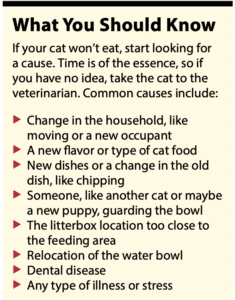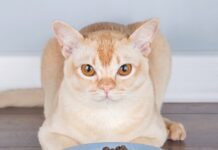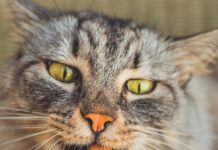For us humans, an intermittent waning of appetite is not usually an immediate cause for concern, but it may well be for a cat. In felines, a loss of appetite (anorexia) can make them ill, and if they don’t eat for as few as three days, they can develop a life-threatening illness, especially kittens, senior cats, and cats with chronic health issues.
The reason is the way cats metabolize their food. A cat who doesn’t eat still needs energy to support her physical functions, so her body pulls fuel from body fat. Unfortunately, the feline liver can’t process the large amounts of fat that can be mobilized when cats do not eat, and they can develop fatty liver syndrome, or “hepatic lipidosis.” This potentially fatal disease occurs when fats in the form of triglycerides accumulate in the liver and alter its normal function.
“The average cat can probably go three to four days without risk of hepatic lipidosis, which is the major concern with feline starvation. Cats that are overweight to obese will often be at a higher risk of getting hepatic lipidosis than leaner cats. But I would say a few days is tops,” says Joe Wakshlag, DVM, PhD, professor in the sections of clinical nutrition and sports medicine and rehabilitation at Cornell University’s College of Veterinary Medicine.
Ideally, you want to get your cat back to eating before she starts to have metabolic problems. If your cat skips food for more than one or two days, you should call your veterinarian. If you are feeding free dry food, it’s important that you are aware of your normal “refill” pattern so you can catch that lack of appetite right away.
It can be tough to determine if your cat is sick, because cats are champions at hiding those symptoms. But remember, a fever will decrease her appetite, as will any respiratory infection. Arthritis or an injury or sore paw could make it difficult for her to reach her bowl. For cats with nausea, it can be important to control that first, before offering foods.
Offering Alternatives
It’s usually OK to try to get your cat to eat on your own—but for no more than 24 hours—before calling the vet.
If your cat is stressed, leave her in familiar territory and shut any other pets out. Use some calming feline pheromones in the room where she normally eats. For some cats, catnip can stimulate appetite.
Start by making sure you are offering fresh food. If some canned food has been out for a couple of hours, pitch it. Warm the food up. Stir it before serving to be sure it’s not overheated in different areas or generally too hot. Make sure all food dishes are clean.
Consider adding some liquid with a strong and attractive odor, like low- salt chicken broth or the juice from a can of tuna packed in water. Small amounts of tasty tidbits, such as cooked chicken breast or mashed up sardines (plain ones) may work. Dabbing a tiny bit of tasty, smelly food on your cat’s paws or her nose can stimulate her to lick it off and inspire some eating.
Dr. Wakshlag says his favorite food-based appetite stimulant is Churu paste, which is a lickable cat treat that is available in various flavors.
 “This stuff top dressed or even given alone is very palatable and can sometimes jump start appetite or get a cat eating again,” says Dr. Wakshlag, “but, of course, the cause of the anorexia must also be addressed. While the cause is being determined, hospitalized cats who are not eating may require that a nasogastric tube be placed to provide liquid nutrition to prevent the development of hepatic lipidosis.”
“This stuff top dressed or even given alone is very palatable and can sometimes jump start appetite or get a cat eating again,” says Dr. Wakshlag, “but, of course, the cause of the anorexia must also be addressed. While the cause is being determined, hospitalized cats who are not eating may require that a nasogastric tube be placed to provide liquid nutrition to prevent the development of hepatic lipidosis.”
Mirtazapine is an appetite stimulant and an antiemetic (a drug that decreases the likelihood of vomiting/nausea) and can be given orally or transdermally (applied to the inside of your cat’s ear) to cats suffering from anorexia. Elura (capromorelin oral solution) is an FDA-approved medication to encourage eating in cats with chronic kidney disease. Cyproheptadine can increase a cat’s appetite, although this medication is not FDA-approved, so it is used “off label.” Any medications should be used with veterinary guidance, as there are some drug interactions and contraindications to be aware of.
The Most Difficult Cases
For the hard-core anorexic cat, feeding tubes may need to be placed to provide direct nutrition. These will require sedation or anesthesia. Choices range from nasogastric to esophagostomy to gastrostomy tubes. These tubes remain in your cat and allow feeding directly to the stomach. Gastrostomy tubes are usually the best long-term (more than a few days) option, and many of these cats can be managed at home with a dedicated owner and a tolerant cat.




